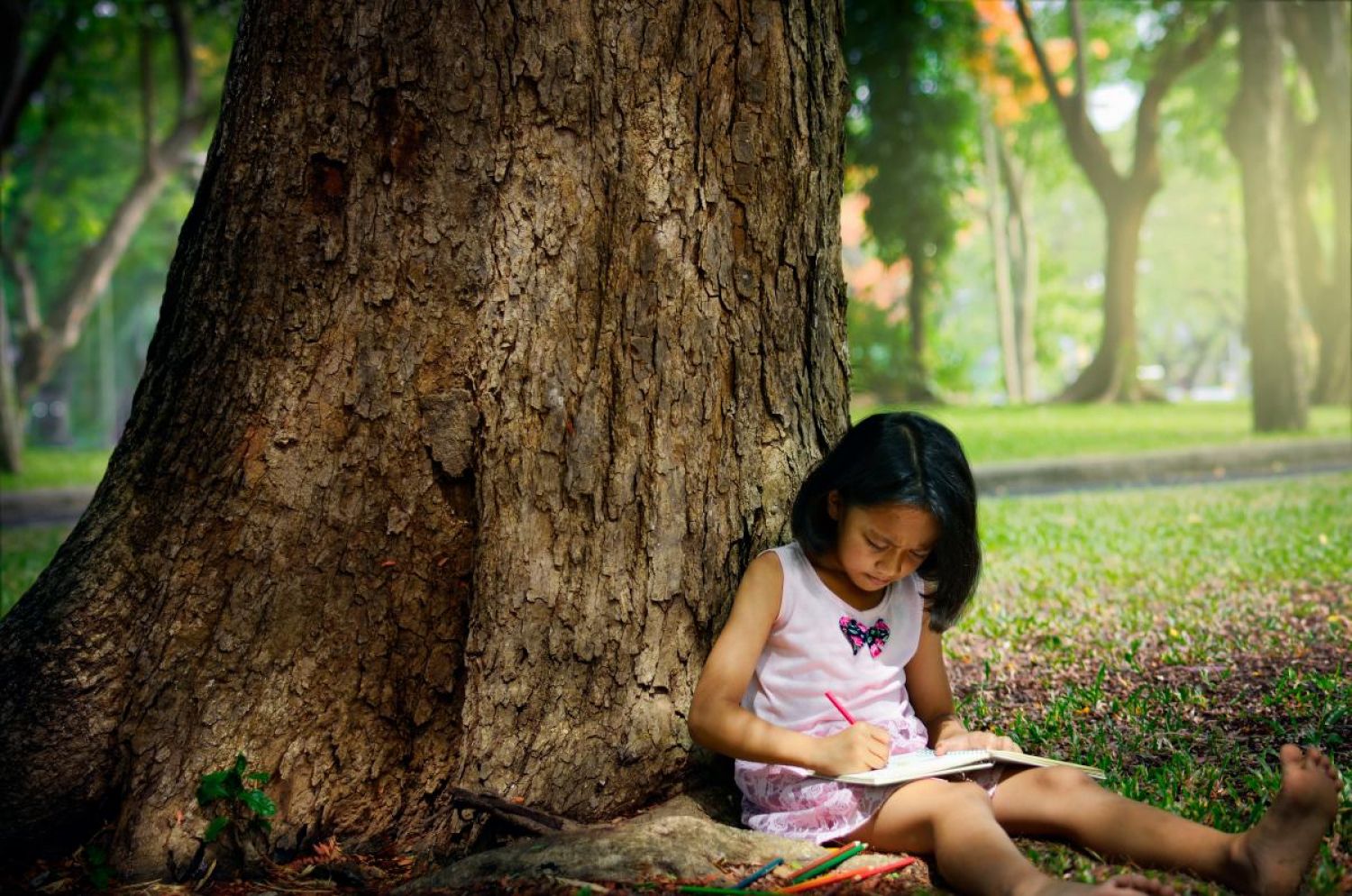Overview
Study from Stanford University Researchers Details Evidence That Early Childhood Environmental Education Delivers Many Benefits for Young Learners
Research shows what educators, policymakers, and parents have recognized for years: early childhood environmental education can positively impact young children’s development.
What Is Early Childhood Environmental Education (ECEE)?
This study uses a broad definition of ECEE aligned with the North American Association for Environmental Education’s (NAAEE) definition: “Environmental education in early childhood is a holistic concept that encompasses knowledge of the natural world, as well as emotions, dispositions, and skills” (NAAEE, 2016, page 2). As such, the research team acknowledges and values multiple variants of and approaches to ECEE including, but not limited to, nature-based early childhood education and early childhood education for sustainability. These, and related approaches, share a common aim of developing a local, regional, and global community of environmentally active people through engaging young children in meaningful, relevant environmental learning experiences (Davis & Elliott, 2014; Wilson, 1996).
To conduct the review, researchers analyzed 66 studies published between 1995 and 2016 that examine commonly identified and measured ECEE program outcomes. The team identified studies for analysis through conducting a systematic search-and-screen process seeking those that met criteria for relevance and quality. For additional information on the research methodology used for all the identified outcome areas for the eeWORKS project, please see From Anecdotes to Evidence: Diving into the Research Review Process.
Bottom Line
The Stanford team’s analysis found overwhelming evidence supporting that ECEE can provide wide-ranging benefits for children, such as increased learning in a range of areas such as mathematics, science, language, and literacy, enhanced social and emotional skills, and improved physical development. ECEE programs can also improve environmental literacy outcomes such as environmental cognition, attitudes, and behavior, while building knowledge and skills that lay the foundation for more environmentally responsible and engaged adults.
In Summary
This literature-review study by Stanford University researchers, documents that ECEE has powerful benefits for children's cognitive, social and emotional, and physical development. Environmental literacy, such as environmental cognition, attitudes, and behaviors, were the most frequently documented outcomes among the studies in the analysis. The results suggest opportunities, in the short and longer term, for laying the groundwork for these young children to take action to improve and protect the environment in the future. These programs, diverse in their design and implementation, emphasize the importance of nature-rich settings, play and movement, and effective guidance by mentors such as teachers, school staff, and even researchers in bringing about the abundance of positive benefits documented in this analysis.
References
Ardoin, N., and Bowers, A. (2020). Early childhood environmental education: A systematic review of the research literature. Educational Research Review, Volume 31, Article 100353. https://doi.org/10.1016/j.edurev.2020.100353
Davis, J., & Elliott, S. (2014). Research in early childhood education for sustainability: International perspectives and provocations. New York, NY: Routledge.
North American Association for Environmental Education. (2016). Early childhood environmental education programs: Guidelines for excellence. Washington, DC: Author.
Wilson, R. A. (1996). Environmental education programs for preschool children. The Journal of Environmental Education, 27(4), 28–33. https://www.tandfonline.com/doi/abs/10.1080/00958964.1996.9941473.
Key Findings
Stanford University Study Details Evidence That Early Childhood Environmental Education Delivers Many Benefits for Young Learners
Download the full Executive Summary
Snapshot of Findings
Research shows what educators, policymakers, and parents have recognized for years: early childhood environmental education can positively impact young children’s development. A research team at Stanford University conducted a systematic analysis of the peer-reviewed literature to identify what studies report about the effects of environmental education for children from infancy to age eight (Ardoin, N., and Bowers A., 2020).
- Four- and five-year-olds were the most frequently studied age group, with few studies reporting programs with the youngest audiences (one-year-olds and infants).
- The reviewed studies emphasized the vital role of adult mentors, teachers, and facilitators as companions and guides in the learning process, supporting young children’s environmental learning experiences. Across the reviewed studies, mentors for early childhood environmental education included teachers, school staff, parents, and researchers, among others.
- The diversity of programs in the reviewed studies highlights ECEE’s versatility, demonstrating that programs exist in many different formats and settings. ECEE can be undertaken with modest resources, with either on- or off-site locations, and with a range of types of outdoor access. A large portion (83%) of the programs included time outside and/or in a nature-rich setting, while others occurred primarily indoors, using classroom resources to stimulate and support environmental learning. The majority (94%) took place in formal settings (i.e., a school, daycare, or early childhood education center), with only 6% in nonformal settings (e.g., nature center or park).
- In the articles reviewed by the research team, the most frequently reported outcomes were related to the category of Environmental Literacy Development, which was evident in 50 (76%) of the studies. Thirty-five (53%) of the studies reported outcomes other than, or in addition to, Environmental Literacy Development, including Cognitive Development (25 studies, 38%), Social and Emotional Development (25 studies, 38%), Physical Development (14 studies, 21%), and Language and Literacy Development (6 studies, 9%).
- In the 66 reviewed studies, the research team found that 82% reported positive findings, and no studies reported negative findings.
Tools
Communication Tools
Based on Stanford's review, we have translated these findings into an Executive Summary and Key Findings for EE professionals to substantiate their work and bolster early childhood environmental education support. This tool includes quotes, statistics, researcher observations, inspiring stories from across the field substantiated by empirical studies, and more.
Download the full Executive Summary
Process
From Anecdotes to Evidence: Diving into the Research Review Process
Download the Research Review Process
What is the impact of environmental education (EE)? What outcomes are important in the field? What do EE programs strive to attain, with which audiences, and in what settings? What existing evidence documents effective approaches related to the range of desired EE outcomes?
Questions like these motivated NAAEE and colleagues, including an expert Advisory Board, to develop eeWORKS, an initiative to coalesce existing research within the field through a series of systematic literature reviews.
The eeWORKS team at NAAEE, along with researchers at collaborating universities, focuses a three-part process to:
- Identify relevant outcome areas and themes of interest.
- Conduct research reviews.
- Communicate and share.
Research
This study uses a broad definition of ECEE aligned with the North American Association for Environmental Education’s (NAAEE) definition: “Environmental education in early childhood is a holistic concept that encompasses knowledge of the natural world, as well as emotions, dispositions, and skills” (NAAEE, 2016, page 2). As such, the research team acknowledges and values multiple variants of and approaches to ECEE, including but not limited to nature-based early childhood education and early childhood education for sustainability. These related approaches share a common aim of developing a local, regional, and global community of environmentally active people by engaging young children in meaningful, relevant environmental learning experiences (Davis & Elliott, 2014; Wilson,1996). To conduct the study, researchers analyzed 66 studies published between 1995 and 2016 that examine commonly identified and measured ECEE program outcomes. The team identified studies for analysis by conducting a systematic search-and-screen process to seek those that met relevance and quality criteria.
For additional information on the research methodology used for all the identified outcome areas for the eeWORKS project, please see From Anecdotes to Evidence: Diving into the Research Review Process.
Ardoin, N., and Bowers, A. (2020). Early childhood environmental education: A systematic review of the research literature. Educational Research Review, Volume 31. Article 100353.




